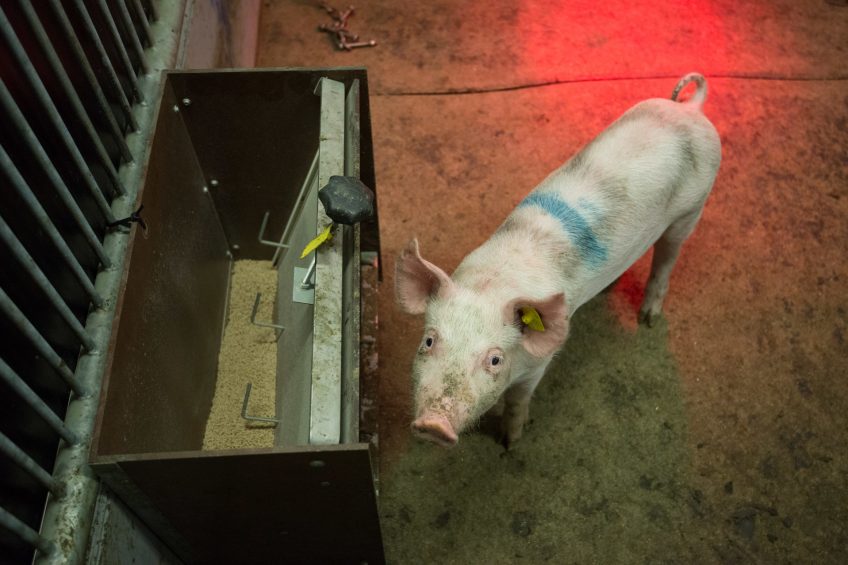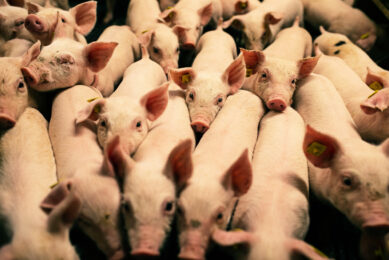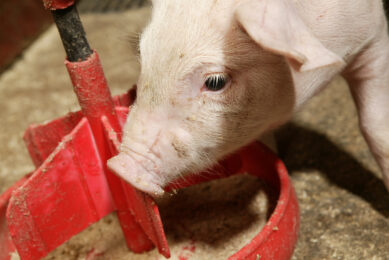How to get every piglet eating

The relationship between creep feeding, exploratory behaviour and the motivational characteristics of piglets are all elements to consider for a successful weaning transition. A three-stage research project being carried out at Wageningen University and Research, the Netherlands, is preparing to fill in some of the knowledge gaps.
Chewing, rooting, biting – as soon as piglets are born in nature, their young life revolves around those activities. As from a very young age, the inquisitive piglets in forests play with acorns and discover all kinds of other different structures, especially when they are somewhere between 3 and 6 weeks of age. The piglets can take their time to get used to eating solids exclusively as weaning usually happens anywhere between nine and 22 weeks.
Gains to be found from nature?
Now compare that to the situation on commercial farms, where weaning happens at three to four weeks. In order to prepare the animals for solid feed as well as possible in that time, creep feeding is often offered. This supplemental feed in the pre-weaning period, can be in the form of a pellet, liquid, meal or mash. Quite a difference from what is happening in nature, and it appears that pig farming in commercial settings may be able to learn a thing or two from the natural behaviour of piglets. Is it possible to make gains during weaning, through the use of creep feed? PhD students Anouschka Middelkoop and Raka Choudhury of Wageningen University and Research are currently carrying out a three-stage project, to determine just that, as Middelkoop told Pig Progress in an interview.
- The first stage is to study the development of behaviour and gut microbiota of piglets that are creep fed versus those which are non-creep fed. Also, effects on metabolism and the immune system will be examined. Here, the project focuses mainly on creep feed as a solid feed.
- The second stage aims to find strategies that improve early feed intake and the proportion of piglets that consume solid feed during the suckling period.
- The third stage to complete the PhDs will focus mainly on in-depth mechanisms about creep feeding, for example, molecular and long-term effects.
Initially, the studies will focus on the weaning period but to conclude the pigs will be followed throughout the nursery phase to examine what, if any, long term effects of creep feeding there are on final growth and performance. Here, Middelkoop and Choudhury also hope to gain more insights into gut health and what is happening with the microbiota and how this can be linked back to piglet behaviour in the pre-weaning stage.
Variability to be explored
Creep feeding has seen a development in quality over the years, Middelkoop says. Initially, creep feeding was all about the palatability of the feed, but now there is more interest in gut health and the possibility to combine early feeding with fibres. “Creep feeding fascinates me because there is a lot of variability. A great proportion of pigs do not consume the feed before they are weaned, so for me it is really interesting to check which piglets are eating and how we can stimulate the others to eat the feed,” Middelkoop explained. “It also interests me when they start to eat the feed and whether there is any variability in that. Some may start shortly before weaning, for example, 2 days before weaning and others may start feeding from one week of age. So uncovering the variability in feed intake between, but especially within litters on an individual piglet level, is what interests me.”
“There have been quite some studies in literature which tried to stimulate pre-weaning feed intake, but not one has succeeded yet in getting every single piglet eating before weaning, so it will be hard and I’m not sure if I am going to manage to succeed either. At least I hope to get more insight into what it would take to stimulate a pig to eat and how we can deal with that in a farm setting.”
Is diversity the key to success?
A strategical part of the project, is how to stimulate feed intake but also the amount of piglets that actually eat the feed. In line with this, the team did an experiment to examine what happens when piglets are offered a diverse diet, see below “Swapping chips for chocolate”. This diversity idea also comes from nature, where pigs have access to all different kinds of structures, such as branches, acorns, etc. This idea has been implemented into creep feed through the use of pellets that differ in multiple sensory properties such as nutrient composition and size, to enhance feed intake. The hypothesis is that the more diverse the diet, the more stimulating it might be.
Benefits to post-weaning performance
In the past, around the world, there have been many studies that compared the performance of pigs throughout the weaning transition in litters which were creep fed and non-creep fed, but there were no clear differences there. Middelkoop has an explanation for this: “When comparing the performance of litters with and without creep feed, the performance is actually not that much better in creep fed litters. Therefore, I was interested in why. If you compare within the creep fed litters which piglets are eating and which are not, however, those piglets that are not eating are removing the effect of the success of creep feeding. What you then find, is that indeed eaters within creep fed litters are doing better than non-eaters in terms of feed intake post-weaning, ADG and gain to feed ratio. So then, you actually start to see the success of creep feeding. Then to zoom in further, if you have eaters, can you compare good (high creep feed intake level) and bad (low creep feed intake level) eaters? Then again, good eaters are doing better than bad eaters in terms of growth and feed intake post-weaning.”
An important part of the further research, therefore, is to find out what motivates a pig to start eating and can the non-eaters be motivated to start eating early. Piglets which are (good)eaters pre-weaning will have a shorter latency to start eating after weaning and a higher initial feed intake. It is thought that this has benefits for gut health, as the gastrointestinal tract would be empty for a shorter period of time, which means less potential problems with diarrhoea, etc. This is also something Middelkoop and Choudhury hope to determine: “I think that good eaters are in general better in their growth performance and feed intake after weaning but there needs to be more clarity in terms of diarrhoea and gut health. A study found that bad eaters tended to have a lower diarrhoea prevalence compared to good eaters and non-eaters. On the other hand, piglets that were provided with creep feed at an early age had less severe diarrhoea compared to piglets that were provided with creep feed just one week before weaning, so the picture is not clear. In the first and third stages of the project we want to explore in more detail the gut health of the piglets and how that is linked to gut microbiota composition, gut morphology and physiology,” Middelkoop explained.
“Farmers are also keen to get more insight into the effects of creep feeding, because if provided properly it pays off very quickly for them. If farmers can be shown that this will improve their animal’s performance then they are more willing to invest in the additional feed. I think this research could be more influential to farmers as most other studies are carried out from a nutritional point of view, so looking at the composition of creep feed. I think the first step is to stimulate that the piglets eat it, and then you can think of all kinds of ways to stimulate the gut development, for example.”
Middelkoop and Choudhury started the project in January 2016 and aim to complete their PhD study in January 2020.
“Swapping chips for chocolate”
![Photo: Anouschka Middelkoop Photo: Anouschka Middelkoop]() Photo: Anouschka Middelkoop
Photo: Anouschka Middelkoop

One approach to familiarise pigs with solid feed at an early age might be by providing feed in a variety of forms, using diversity or novelty to stimulate the pigs’ foraging behaviour. The effect of dietary diversity (i.e. offering two diverse feeds simultaneously) vs. novelty (i.e. regularly changing the flavour of one feed) on the foraging behaviour and feed intake of suckling pigs was studied. “I can imagine that if you eat a lot of chips you might not want to eat chips anymore, you might want to eat chocolate now,” muses Middelkoop, who then hypothesised that piglets, rather than sampling from one feed only, would prefer a diverse diet. In the experiment, piglets received ad libitum feed from 2 days of age in 2 feeders per pen.
- In treatment one (T1) 10 pens of pigs were given feed A and feed B which differed in size, flavour, composition, smell, texture and colour.
- In treatment two (T2), 9 pens of pigs received feed A plus feed A to which four different additional novel flavours were added from day 6 in a daily sequential order.
The feeding behaviour was studied by weighing feed remains and performing behavioural observations. Observations were also used to determine ‘eaters’ (i.e. pigs scored eating at least once). Piglets did not prefer feed A or B within T1 and did not have an overall preference for feed A with or without flavour novelty within T2. Only a few piglets were observed eating only one of the feeds throughout lactation. Interestingly, T1-litters ate much more than T2-litters and explored the (feed in the) feeders more often. This also implies that feed A, the common feed provided in T1 and T2, was more consumed in T1 compared to T2. The percentage of eaters within a litter did not differ over time between the treatments. These results suggest that piglets like to eat a varied diet instead of preferring one feed over the other.
Dietary diversity by providing 2 feeds at the same time different in flavour, size, composition, smell, texture and colour stimulated the feed intake and feed-related exploratory behaviour of suckling pigs more than dietary diversity via novel flavours only, but did not elicit pigs to start eating earlier.
2nd Author: Vincent ter Beek











